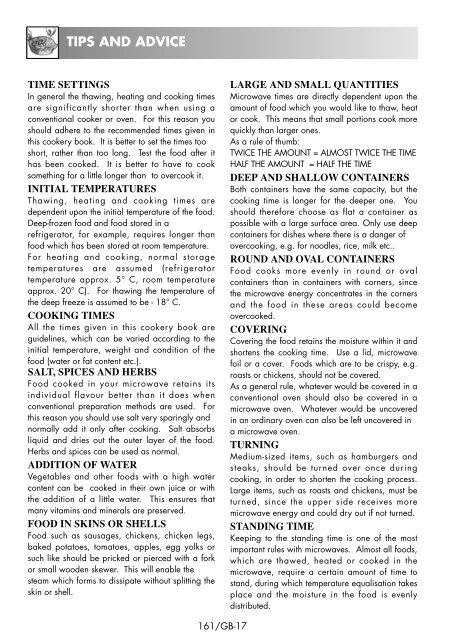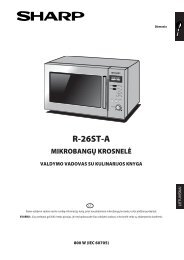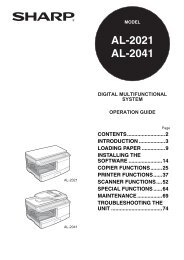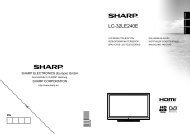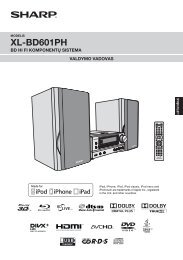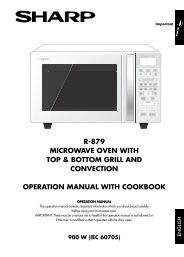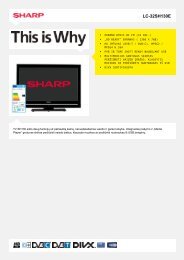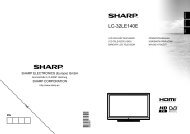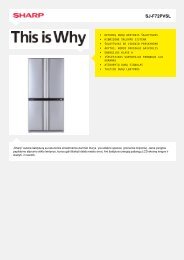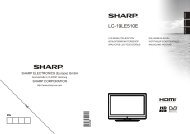R-26ST Operation-Manual GB - Sharp Central & Eastern Europe
R-26ST Operation-Manual GB - Sharp Central & Eastern Europe
R-26ST Operation-Manual GB - Sharp Central & Eastern Europe
Create successful ePaper yourself
Turn your PDF publications into a flip-book with our unique Google optimized e-Paper software.
7. R-<strong>26ST</strong> English 27.01 27/1/06 4:59 PM Page 18<br />
TIPS AND ADVICE<br />
TIME SETTINGS<br />
In general the thawing, heating and cooking times<br />
are significantly shorter than when using a<br />
conventional cooker or oven. For this reason you<br />
should adhere to the recommended times given in<br />
this cookery book. It is better to set the times too<br />
short, rather than too long. Test the food after it<br />
has been cooked. It is better to have to cook<br />
something for a little longer than to overcook it.<br />
INITIAL TEMPERATURES<br />
Thawing, heating and cooking times are<br />
dependent upon the initial temperature of the food.<br />
Deep-frozen food and food stored in a<br />
refrigerator, for example, requires longer than<br />
food which has been stored at room temperature.<br />
For heating and cooking, normal storage<br />
temperatures are assumed (refrigerator<br />
temperature approx. 5° C, room temperature<br />
approx. 20° C). For thawing the temperature of<br />
the deep freeze is assumed to be - 18° C.<br />
COOKING TIMES<br />
All the times given in this cookery book are<br />
guidelines, which can be varied according to the<br />
initial temperature, weight and condition of the<br />
food (water or fat content etc.).<br />
SALT, SPICES AND HERBS<br />
Food cooked in your microwave retains its<br />
individual flavour better than it does when<br />
conventional preparation methods are used. For<br />
this reason you should use salt very sparingly and<br />
normally add it only after cooking. Salt absorbs<br />
liquid and dries out the outer layer of the food.<br />
Herbs and spices can be used as normal.<br />
ADDITION OF WATER<br />
Vegetables and other foods with a high water<br />
content can be cooked in their own juice or with<br />
the addition of a little water. This ensures that<br />
many vitamins and minerals are preserved.<br />
FOOD IN SKINS OR SHELLS<br />
Food such as sausages, chickens, chicken legs,<br />
baked potatoes, tomatoes, apples, egg yolks or<br />
such like should be pricked or pierced with a fork<br />
or small wooden skewer. This will enable the<br />
steam which forms to dissipate without splitting the<br />
skin or shell.<br />
LARGE AND SMALL QUANTITIES<br />
Microwave times are directly dependent upon the<br />
amount of food which you would like to thaw, heat<br />
or cook. This means that small portions cook more<br />
quickly than larger ones.<br />
As a rule of thumb:<br />
TWICE THE AMOUNT = ALMOST TWICE THE TIME<br />
HALF THE AMOUNT = HALF THE TIME<br />
DEEP AND SHALLOW CONTAINERS<br />
Both containers have the same capacity, but the<br />
cooking time is longer for the deeper one. You<br />
should therefore choose as flat a container as<br />
possible with a large surface area. Only use deep<br />
containers for dishes where there is a danger of<br />
overcooking, e.g. for noodles, rice, milk etc..<br />
ROUND AND OVAL CONTAINERS<br />
Food cooks more evenly in round or oval<br />
containers than in containers with corners, since<br />
the microwave energy concentrates in the corners<br />
and the food in these areas could become<br />
overcooked.<br />
COVERING<br />
Covering the food retains the moisture within it and<br />
shortens the cooking time. Use a lid, microwave<br />
foil or a cover. Foods which are to be crispy, e.g.<br />
roasts or chickens, should not be covered.<br />
As a general rule, whatever would be covered in a<br />
conventional oven should also be covered in a<br />
microwave oven. Whatever would be uncovered<br />
in an ordinary oven can also be left uncovered in<br />
a microwave oven.<br />
TURNING<br />
Medium-sized items, such as hamburgers and<br />
steaks, should be turned over once during<br />
cooking, in order to shorten the cooking process.<br />
Large items, such as roasts and chickens, must be<br />
turned, since the upper side receives more<br />
microwave energy and could dry out if not turned.<br />
STANDING TIME<br />
Keeping to the standing time is one of the most<br />
important rules with microwaves. Almost all foods,<br />
which are thawed, heated or cooked in the<br />
microwave, require a certain amount of time to<br />
stand, during which temperature equalisation takes<br />
place and the moisture in the food is evenly<br />
distributed.<br />
161/<strong>GB</strong>-17


